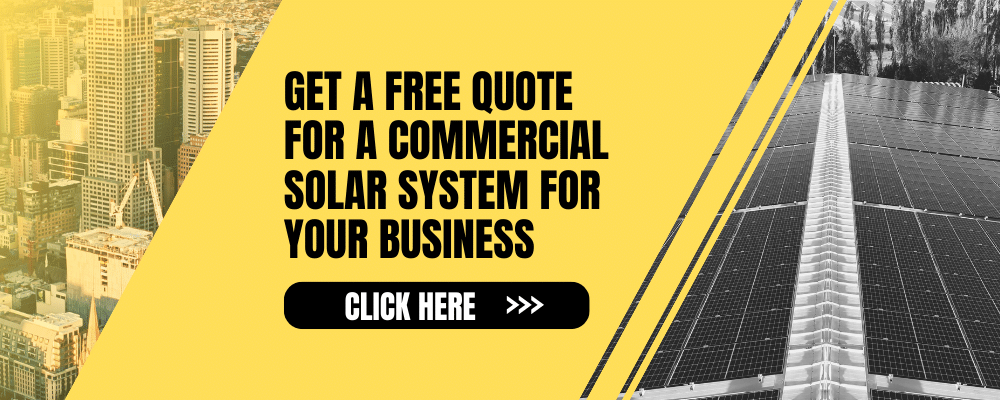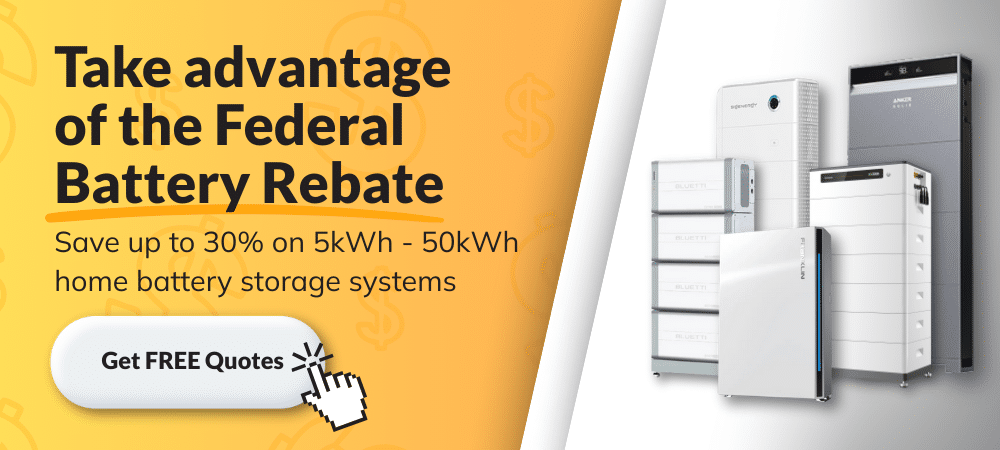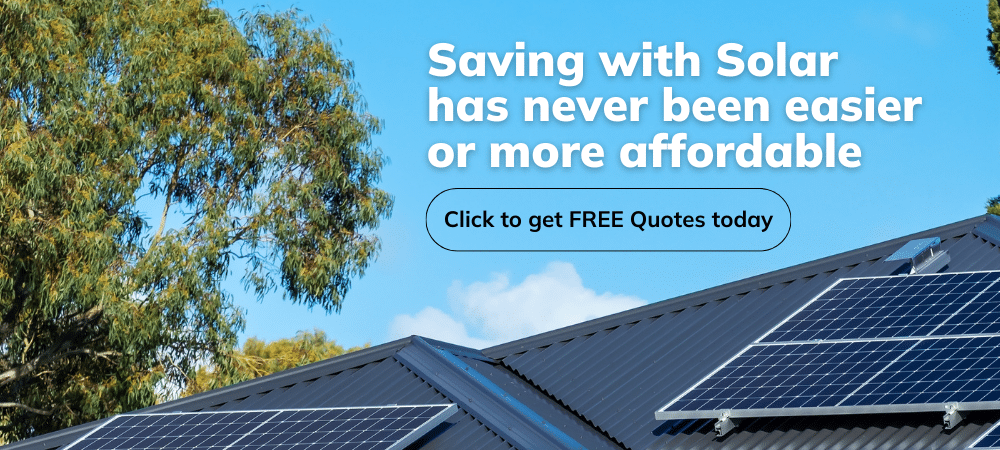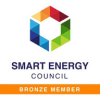The popularity of electric vehicles (EVs) is increasing year on year across Australian households. As old cars make way for new ones and families seek to minimise their expenses, EVs are fast becoming the vehicle of choice. With their large batteries and ability to be charged at home, it’s no wonder that bidirectional charging is the next step in the evolution of home energy independence.
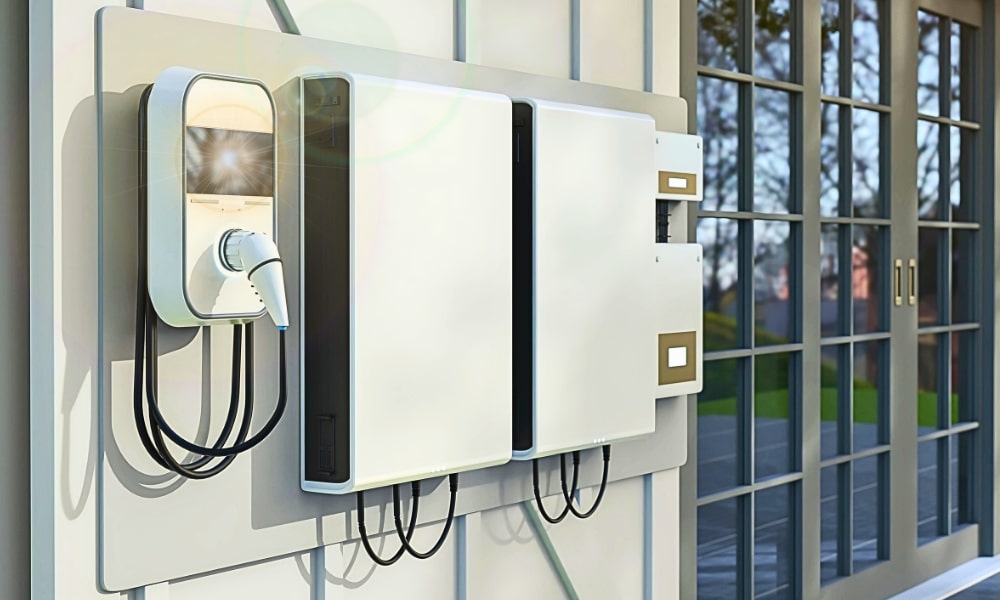
Bidirectional charging uses an EV’s battery to send excess stored energy into the grid or the home, or charge external appliances and devices. Let’s explore this application and what it could mean for Australian households.
On this page
Bidirectional charging - what is it?
Traditional EV chargers allow electricity to flow in one direction—from the grid to the vehicle. Bidirectional charging, however, enables two-way energy flow. This means your EV can not only charge but also discharge electricity back to your home, the grid, or directly to appliances. This capability transforms EVs into mobile energy storage units, enhancing energy flexibility and efficiency
Your electric vehicle typically features a large battery, usually a lithium-ion type. The average storage capacity of an electric vehicle (EV) in Australia ranges from 40 kWh to 100 kWh. To put this in perspective, the average capacity of a home solar battery is 13 kWh. The size of the battery is necessary for transporting individuals and families for hundreds of kilometres.
Use Energy Matters’ easy-to-use solar power and battery storage calculator to determine the size of your solar system with storage! Our solar calculator will generate performance information and potential savings.
We can send this information to 3 of our pre-vetted and trusted local installers in your area to receive obligation-free solar quotes and take the first step towards true energy independence!
With the average family travelling only 33.2 km per day, and an EV using, on average, 20 kWh per 100 km, there’s a substantial amount of ‘leftover’ energy that your EV could potentially be housing. Imagine harnessing a portion of this energy to power your home. Bidirectional charging makes this a reality.
Let’s explore the different types of charging and what these mean for you and your home.
Types of bidirectional charging
Vehicle-to-Home (V2H): Your EV as a home battery
Vehicle-to-Home (V2H) charging is the most exciting form of bidirectional charging. V2H transforms your EV’s battery into a home battery.
V2H enables your EV to function as a home battery, providing electricity during peak hours or power outages. By charging your EV during off-peak times or utilising excess solar energy, you can utilise the stored power when needed, thereby reducing your reliance on the grid and lowering your energy bills.
Benefits of V2H
- Cost savings: Utilise stored energy during expensive peak periods.
- Energy independence: Maintain power during grid outages.
- Sustainability: Maximise the use of renewable energy sources.
Did you know Energy Matters is Australia’s largest renewable news, blog and educational resource? Subscribe to Energy Matters’ weekly newsletter and keep updated even with incentives, rebates and recommended solar product offers.
Vehicle-to-Grid (V2G): Supporting the grid and earning rewards
V2G technology enables electric vehicles (EVs) to feed electricity back into the grid, thereby helping to balance supply and demand. During peak demand periods, your EV can discharge stored energy to the grid, potentially earning you financial incentives or credits.
Advantages of V2G
- Monetary incentives: Participate in programs that compensate you for the energy you supply to the grid.
- Grid stability: Contribute to a more resilient and reliable energy system.
- Environmental impact: Support the integration of renewable energy sources.
Australia is actively exploring Vehicle-to-Grid (V2G) technology through various trials and pilot programs. These initiatives aim to assess the feasibility and benefits of integrating electric vehicles (EVs) into the national energy infrastructure.
Vehicle-to-Load (V2L): Powering devices directly from your EV
V2L enables you to utilise your EV’s battery to power appliances and devices directly, eliminating the need for a grid connection. This feature is handy for:
- Camping: Powering lights, cooking equipment, or electronic devices.
- Worksites: Running tools and machinery in remote locations.
- Emergencies: Providing electricity during outages or natural disasters.
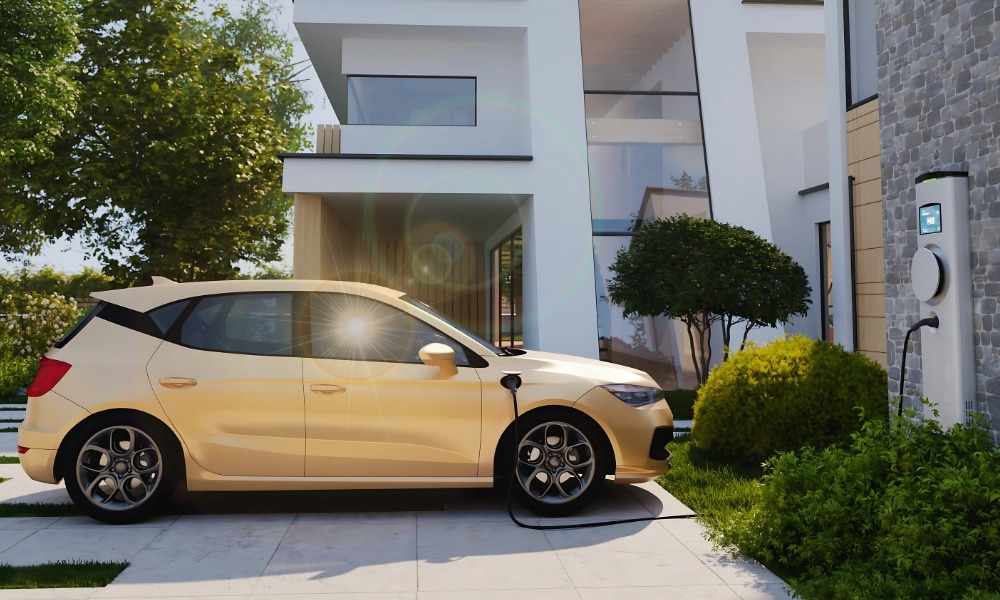
How bidirectional EV charging works: The technical breakdown
How bidirectional EV charging works involves a harmonious interplay of hardware and software. Here’s a simplified breakdown:
- The EV battery: At its heart is the EV’s high-capacity battery, which stores energy in DC (Direct Current) form.
- The bidirectional charger: This specialised charger is the crucial link. Unlike a regular EV charger, it contains an inverter that converts DC power from the EV battery into AC (Alternating Current) power, which is what homes and the grid typically use. It also works in reverse, converting AC from the grid or solar into DC for charging the EV.
- Communication protocols: For seamless operation, the EV, the charger, and potentially the grid (for Vehicle-to-Grid, V2G) need to communicate effectively. Standards like ISO 15118 and OCPP (Open Charge Point Protocol) facilitate this communication, enabling features like “Plug & Charge” and smart energy management.
- Energy Management System: For V2H and V2G, an energy management system (EMS) often coordinates the flow of power. This system can be integrated into the charger or a separate home energy hub. It intelligently determines when to charge the EV, when to discharge it to the home, or when to export it to the grid, based on factors such as electricity prices, solar generation, and household demand.
- Smart metering: For V2G applications, smart meters are crucial for tracking the import and export of electricity, enabling accurate billing and offering financial incentives.
- Off-grid system: In Australia, if you want to use Vehicle-to-Load (V2L) in an off-grid system, you’ll need to connect your EV to a hybrid inverter and maybe a generator inlet via a transfer switch. For off-grid or blackout situations, V2L allows you to utilise the battery of your EV to power household appliances. Source and Image: Clean Energy Reviews
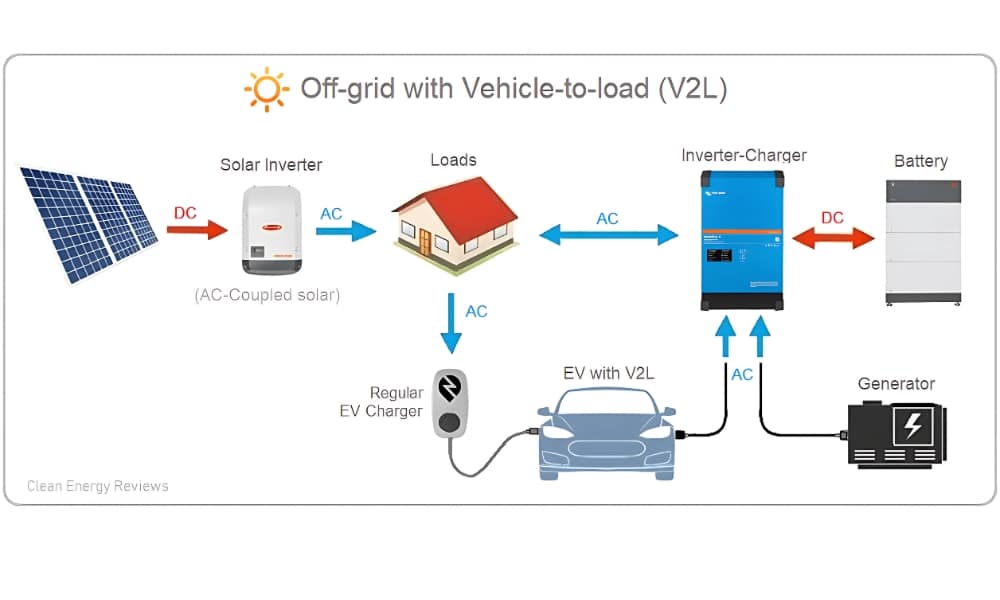
The process of how bidirectional EV charging works involves creating a flexible energy hub within your electric vehicle. When charging, the bidirectional charger draws AC power from the grid or your solar system and converts it to DC to store in the electric vehicle’s (EV) battery. When discharging for V2H or V2G, the process reverses: the charger converts the DC power from the EV battery back into AC, which can then be used by your home or sent back to the grid.
Powering up your EV with solar
If you plan to purchase an electric vehicle (EV), integrating an EV charger into your solar system is a great way to “fuel” your car with clean, renewable energy.
Benefits of V2H, V2G & V2L for Australian homeowners
For Australian homeowners, the benefits of embracing bidirectional charging are multifaceted:
- Reduced energy bills: By using stored solar energy from your EV for your home (V2H) during peak tariff periods, or by selling excess power back to the grid (V2G) when prices are high, you can significantly lower your electricity costs. This leverages the principle of energy arbitrage, maximising the value of your EV battery.
- Enhanced energy independence & resilience: V2H provides a robust backup power solution during grid outages, offering peace of mind. For those with solar panels, it enables greater self-consumption of renewable energy, thereby reducing reliance on the grid.
- Support for renewable energy integration: By acting as flexible storage, your EV contributes to a more stable grid, helping to integrate more renewable energy sources, such as solar and wind, even when their generation is intermittent. This plays a vital role in Australia’s transition to a cleaner energy future.
- Monetisation opportunities (V2G): As V2G programs mature, EV owners can earn income or credits by providing grid services, turning their parked vehicle into a revenue-generating asset.
- Increased practicality (V2L): V2L extends the utility of your EV beyond transportation, making it a versatile power source for various off-grid or emergency needs, from camping trips to powering essential household items during power outages.
Challenges and future outlook
Despite the immense potential, several challenges must be addressed for the widespread adoption of bidirectional charging in Australia.
- Infrastructure and compatibility: As trials progress, the availability of certified bidirectional chargers compatible with a wide range of electric vehicles remains limited. The shift from older CHAdeMO to the more common CCS2 standard is positive, but continued development and certification are crucial. Learn more about the charging connectors in our comprehensive guide.
- Regulatory framework and incentives: While Standards Australia has made progress, clear and consistent national policies and incentives are needed to accelerate uptake. Government grants for V2G projects and clear guidelines for energy trading are vital to encourage investment and participation.
- Battery degradation concerns: EV owners may be concerned about increased battery degradation from frequent charging and discharging cycles. Ongoing research and tiered usage models, similar to Virtual Power Plants (VPPs), will help address these concerns, allowing users to balance battery health with energy benefits.
- Consumer awareness and education: Many Australians are still unaware of the full potential of bidirectional charging. Education campaigns are crucial for highlighting the benefits and guiding consumers through the transition.
- Grid preparedness: While V2G offers grid benefits, network operators must invest in smart grid upgrades and software to effectively manage the two-way flow of energy from millions of electric vehicles (EVs).
The future of bidirectional charging in Australia is auspicious. Projections suggest that by 2040, millions of Australian homes could be utilising bidirectional charging to power their homes and support the grid. As EV sales continue to soar, with over 250,000 Australians already driving EVs as of early 2025, the capacity for distributed energy storage will grow exponentially. Continued research, government support, and industry collaboration are poised to make electric vehicles (EVs) a cornerstone of Australia’s energy resilience and its transition to renewable energy.
EV models supporting bidirectional charging in Australia: Current status and trials
V2G trials in Australia are actively demonstrating the technology’s potential. Essential Energy, a major electricity distributor, has partnered with CSIRO and Sigenergy to confirm that CCS2 V2G technology is “market-ready” for their network, following successful trials with vehicles such as the Ford F-150 Lightning and Nissan Leaf.
Similarly, V2H trials in Australia are progressing, with Australian manufacturers such as RedEarth Energy Storage partnering to produce bidirectional chargers locally for V2H. Several successful V2H trials have been conducted with popular electric vehicle (EV) models, including the BYD Atto 3, Tesla Model Y, Volvo EX30, Mitsubishi Outlander PHEV and MG4, indicating strong potential for widespread adoption.
Several EV models available in Australia support V2L, including:
- Hyundai Ioniq 5: Equipped with V2L functionality.
- Kia EV6: Supports V2L features
While V2G, V2H, and V2L infrastructure are still nascent, the regulatory framework is evolving. Standards Australia approved new regulations for Vehicle-to-Everything (V2X) technology in late 2024, paving the way for broader implementation of this technology.
To enhance road safety and efficiency, V2X technology, which enables vehicles to interact with both infrastructure and other vehicles, is being investigated and implemented in Australia. This includes Cellular Vehicle-to-Everything (C-V2X), which facilitates communication between vehicles and infrastructure by utilising mobile data networks.
Sources: PSC Energy – Bidirectional EV Charging in Australia Explained: Your Guide to V2G, V2H, and V2L | Elite Power Group – V2G, V2L & V2H Explained: Vehicle to Grid in Australia 2025 | Clean Energy Reviews – Bidirectional EV charging explained – V2G, V2H & V2L | CSIRO – New study brings vehicle-to-grid technology a step closer in Australia | Automative Testing Technology International – Australian V2X project enables autonomous vehicles to see round corners
Embrace the future of energy with bidirectional charging
Bidirectional charging is more than a technological advancement; it’s a step towards a sustainable and resilient energy future. By integrating V2H, V2G, and V2L into your energy strategy, you can optimise power usage, reduce costs, and contribute to a greener Australia. Energy Matters is committed to helping you navigate this exciting journey. Explore our resources and take the first step towards smarter energy solutions today.
Contact Energy Matters today for free, no-obligation solar quotes on bidirectional charging solutions, home batteries, and solar systems. Don’t just drive your EV; empower your home and contribute to Australia’s sustainable energy future. Take control of your energy destiny – talk to our solar experts now!








